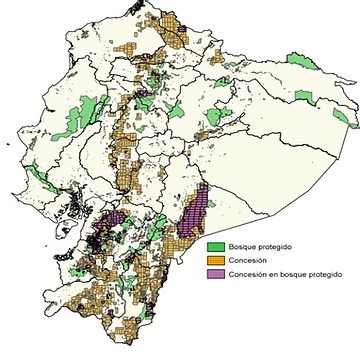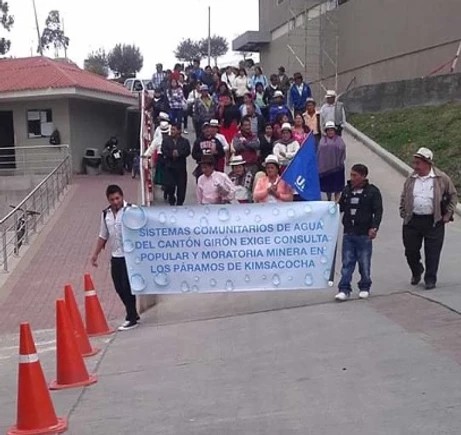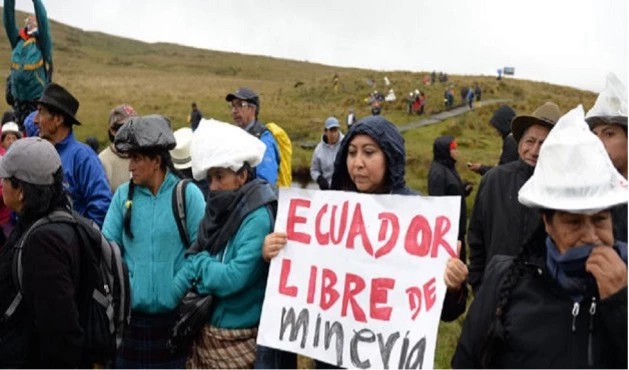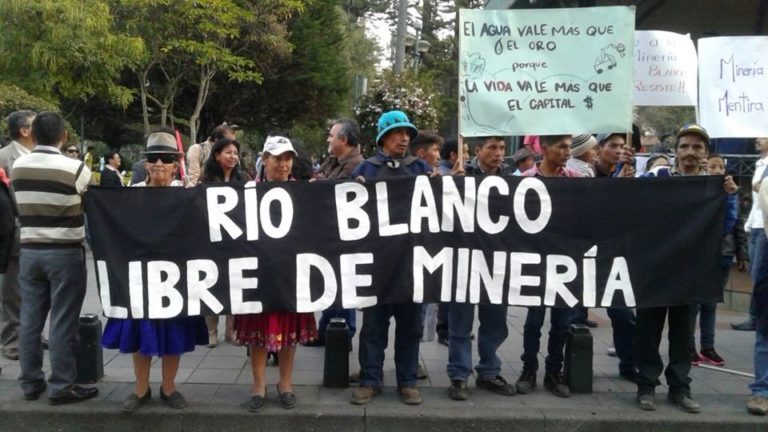Residents of Cuenca, in Azuay province, voted overwhelmingly in a ‘consulta popular’ to ban mining that would affect key water resources. The incoming president, Guillermo Lasso, may find it hard to ignore this result.
This article first appeared on the website of Latin American Geographies UK. You can read the original here in English, or here in Spanish. Main image: ‘Río Blanco free from mining’. Extractivismo.com
The mining industry’s problems in obtaining a ‘social licence to operate’ in Latin America were highlighted once again in February, when residents of the Ecuadorian city of Cuenca (Azuay province) voted overwhelmingly to ban large and medium-scale mining near five ‘water recharge zones’ near the sources of the Tarqui, Yanuncay, Tomebamba, Machángara and Norcay rivers.
The right to hold a referendum (consulta popular) on the issue was won following a campaign by the People’s Council for the Water of Cuenca, which is comprised of 14 social and peasant organizations, social leaders, researchers, academics and environmentalists. The Constitutional Court gave the go-ahead for the vote in September 2020.
It was eventually held alongside the country’s presidential elections on 7 February, with 80 per cent of the electorate rejecting mining. This victory is the result of an intensive awareness-raising campaign about the destructive effects of mining on communities and the environment, in an area known for its unique ecosystems and the quality of its water.
‘Either we drill holes in the páramo, or we conserve it’

The five rivers in question provide communities with water for drinking, irrigation, livestock, aquaculture, agrobiology and hydroelectricity generation, and mining activity in these areas would put at risk not only local livelihoods, but also the abundant biodiversity of the páramos. This is a unique neotropical wetland ecosystem of the northern Andes, playing a significant role in the functioning of the local water system, providing rivers with water which they store from rain, fog, and glacial runoff.
There are around 765 mining concessions in the Cuenca canton alone, all of which overlap with páramo areas given the status of Protected Forests and Vegetation (Bosques y Vegetación Protectores). Azuay is by no means the only area in Ecuador where such overlap occurs, as can been seen in the map here.

Azuay also has three areas that fall within the National System of Protected Areas (SNAP) – the Las Cajas National Park, the Quimsacocha National Recreation Area and the Community Protected Area Marcos Pérez de Castilla – all of which contain páramo ecosystems. Azuay also contains a 2% sliver of the Río Negro-Sopladora National Park, the rest of which is in neighbouring province Morona Santiago.
Unlike the protected forests, mining is completely forbidden in SNAP areas, a blanket ban having been brought in when the Ecuadorian people were given a vote on the issue in 2018. However, this still leaves many páramos in Azuay vulnerable to exploitation.
‘Large-scale metal mining projects in Cuenca require the removal of enormous amounts of soil from areas that should be destined for conservation,’ states the People’s Council on the website for the consulta. ‘Mining is incompatible with the conservation of water sources: either we drill holes in the páramo, or we conserve it. You cannot do both at the same time.’
A strategic industry?
Ecuador is considered a high-potential destination by the mining industry, with abundant metal reserves – primarily gold, silver and copper – which remain relatively untapped when compared to other countries in the region, particularly its neighbour Peru. Mirador, Ecuador’s first open-pit industrial mining project, did not begin operations until 2019.
The decline in oil prices has had a big impact on Ecuador’s economy and recent governments have attempted to attract mining investment as a means of making up the shortfall. In 2015, the government hired the consultants Wood Mackenzie to help the country make its mining sector more attractive to transnationals. Since then, foreign direct investment has increased by 200%.
The government has identified five mining projects it considers ‘strategic’ and two of them are located in Azuay: Loma Larga and Rio Blanco, with the latter concession positioned right on the edge of Las Cajas National Park. Las Cajas is home to the largest concentration of lakes per square kilometre in the world, as well as unique species of flora and fauna.
But prospects do not look good for these two projects. Rio Blanco, belonging to the Chinese consortium Ecuagoldmining, has been suspended since 2018 over failure to consult indigenous communities.
Meanwhile, Loma Larga – a gold-silver-copper project belonging to the Canadian company INV Metals – may well have been sunk by February’s referendum result.
While Jorge Barreno, the manager of INV Metals Ecuador, argues that the referendum result does not apply to existing concessions and will not affect the development of the project, Cuenca mayor Pedro Palacios insists that the referendum result precludes any future exploitation in the watershed areas. As Loma Larga has yet to begin exploiting, it should not be permitted to move any further.

‘A turn of the screw’
Loma Larga has already been forced to relocate some of its installations once. In 2019, the people of the canton of Girón also organised a consulta popular on whether to permit mining within the Quimsacocha water system. The result of seven-year battle, the results of the Girón consulta were similarly decisive: nearly 87% voted to reject the project.
‘As long as mining lurks, no one sleeps peacefully, because death lurks. Our communities are awake, united and determined to die if necessary,’ said Diana Quesada, president of the Kimsakocha Agroecological School. ‘These miners who come to destroy our lives will never be able to enter our communities unless they kill us.’
Though the government portrays mining as an important source of revenue for the country, the actual contribution of the mining sector to Ecuador’s economy is questionable. In 2019, mining exports were worth about $100 million, which is only 1% of the country’s Gross Domestic Product (GDP), though the government wants to push that figure up to 4% in the coming years.
This aspiration is unlikely to change substantially under the incoming president Guillermo Lasso. While Lasso devoted time and energy to environmental concerns before the second round of the elections – meeting with indigenous and environmental groups, promising to promote eco-tourism and, significantly, ban open-pit mining – it is unclear that this was anything more than just a ruse to pick up votes from those who backed environmentalist Yaku Perez in the first round.
Indeed, Lasso has consistently stressed his support for ‘responsible’ mining as a motor of development and source of employment, promising to reduce taxes on the industry and woo foreign investors. In an analysis of the manifestos of the top three presidential candidates by the Environment Front – a coalition of 60 ecological and human rights organisations – Lasso came in last, with a ‘toxic’ score of just 36.5 out of 100.
If Lasso makes any fresh attempt to install mining in Azuay, however, he may find he has his work cut out.
‘The results of the consulta popular represent a turn of the screw in the process of defending our water,’ says David Fajardo Torres, a law student and a leading environmental activist in Cuenca, who worked for the People’s Council on the referendum campaign. ‘Now we have legitimacy, in that practically eight out of ten people in Cuenca are against mining and don’t want the development of these projects,’
‘And this is a sovereign decision,’ he adds. ‘A decision, moreover, taken via a direct democracy mechanism which can’t easily be ignored by the central government or any other authority.’
‘So the political momentum is in our favour.’

About The Heart of Our Earth
The fight of the people of Azuay to protect the páramos will be addressed in more detail in Latin America Bureau’s upcoming project The Heart of Our Earth: community resistance to mining in Latin America. This project will bring together original first-person testimony from people in mining affected communities all over Latin America, from the deserts of Sonora to the mountains of Patagonia. We aim to amplify their voices, document their strategies of resistance and highlight the true social and environmental costs of mining, encouraging reflection and debate on issues such as development, sustainability and the energy transition.
For more information, please visit The Heart of Our Earth on LAB’s website, Facebook and Instagram, and watch the video for our successful 2020 crowdfunding campaign. We do still need funding to complete the project. If you would like to make a donation you can do so at CAF Donate.
Beyond the Campus: LAB’s Research Engagement & Impact (RE&I)
With over 30 years’ experience in publishing and media, existing as a charity which straddles academic and public circles, LAB is offering a range of services to make research more accessible, providing support and advice to help university researchers improve their engagement with the general public and have an impact beyond the usual academic circles. You can download a brochure detailing our services here.
Our first two projects are ‘Indigenous Brazil Violated’ with Cardiff University and ‘Women Resisting Violence’ with King’s College London.

